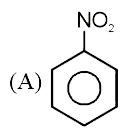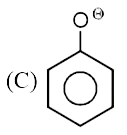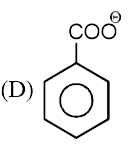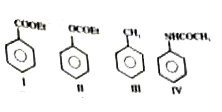The ring systems having following characteristics are aromatic.
(i) Planar ring containing conjugated π bonds .
(ii) Complete delocalisation of the π -electron in ring system i.e. , each atom in the ring has unhybridised p-orbital , and
(iii) Presence of (4n+2)π-electrons in the ring where n is an integer(n = 0, 1, 2, .......) [Huckel rule]. Using this information classify the following compounds as aromatic/non-aromatic.
![The ring systems having following characteristics are aromatic. (i) Planar ring containing conjugated pi bonds . (ii) Complete delocalisation of the pi -electron in ring system i.e. , each atom in the ring has unhybridised p-orbital , and (iii) Presence of (4n+2)pi-electrons in the ring where n is an integer(n = 0, 1, 2, .......) [Huckel rule]. Using this information classify the following compounds as aromatic/non-aromatic.](https://d10lpgp6xz60nq.cloudfront.net/physics_images/ARH_NCERT_EXE_CHM_XI_C13_S01_037_Q01.png)
A = Planar ring, all atoms (C and N) of the ring are up hybridized. It has 6 delocalized π electrons and follows Huckel's rule. Therefore, it is aromatic.
B = Has 6π electrons, but the delocalization stops at sp3 hybridized CH2 carbon. Therefore, it is not aromatic.
C = 6 delocalized π electrons (4π) electrons of the two double bonds and 2 unshared electrons on negatively charged carbon) in a planar ring, follows Huckel's rule. It is aromatic.
D = Has only 4 delocalized π-electrons. It is Anti-aromatic.
E = 6 delocalized π-electrons follows Huckel's rule. π electrons are in sp2 hybridized orbitals, conjugation all over the ring because of positively charged carbon. The ring is planar. Therefore, it is aromatic.
F = Follows Huckel's rule, has 2π electrons i.e., (4n+2) π-electrons where (n=0), delocalized π-electrons. Therefore, it is aromatic
G = 8π electrons, does not follow Huckel's rule i.e., (4n+2) π-electrons rule. It is non aromatic.
Topper's Solved these Questions
- HYDROCARBONSBook:MODERN PUBLICATIONChapter:HYDROCARBONSExercise:NCERT FILE (NCERT EXEMPLAR PROBLEMS) (MATCH TYPE QUESTIONS)
Explore 4 Videos
- HYDROCARBONSBook:MODERN PUBLICATIONChapter:HYDROCARBONSExercise:NCERT FILE (NCERT EXEMPLAR PROBLEMS) (Assertion and Reason Type Questions)
Explore 3 Videos
- HYDROCARBONSBook:MODERN PUBLICATIONChapter:HYDROCARBONSExercise:NCERT FILE (NCERT EXEMPLAR PROBLEMS) (Multiple Choice Questions (Type-II))
Explore 9 Videos
- HALOALKANES AND HALOARENESBook:MODERN PUBLICATIONChapter:HALOALKANES AND HALOARENESExercise:UNIT PRACTICE TEST
Explore 12 Videos
- HYDROGENBook:MODERN PUBLICATIONChapter:HYDROGENExercise:UNIT PRACTICE TEST (for Board Examination)
Explore 9 Videos
Similar Questions
The ring systems having following characteristics are aromatic.
(i) Planar ring containing conjugated π bonds .
(ii) complete dolocalisation of the π -electron in ring system i.e. , each atom in the ring has unbybridised p-orbital , and
(iii) Presence of (4n+2)π-electrons in the ring where n is an integer(n = 0, 1, 2, .......) [Huckel rule]. Using this information classify the following compounds as aromatic/non-aromatic.

View SolutionThe number of π-electrons present in phenol ring are _______ .
View Solution
Knowledge Check
The decreasing order of electron density on the ring is :
 AIII>II>IBII>III>ICI>III>IIDIII>I>II
AIII>II>IBII>III>ICI>III>IIDIII>I>IIWhich of the following compounds has maximum electron density in ring ?
A B
B C
C D
D
Any ring system will be aromatic in nature if it possesses
I.Planarity
II.Complete delocalisation of the π electron in the ring
III.It follows Huckle rule
Choose the correct optionAI and IIBii and IIICI and IIIIDAll of the above
Which of the following ring compounds obeys Huckel's rule ?
View SolutionIn which of the following molecules π-electron density in ring is maximum.
View SolutionThe correct order of electron density in aromatic ring of following compound is :

View SolutionThe correct order of electron density in aromatic ring of following compounds is:

View SolutionIn which of the following molecules π-electron density in ring is maximum?
View Solution
